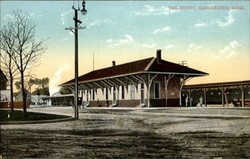From the 17th century many families from England settled in New England where they established homes and families and put down deep roots. Many of the names of the early settlers still prevail in Rowley and in all of the other towns that originally were part of the vast area referred to as "Ould Rowley". As time went on they built their homesteads. Many family members remained in that part of Ould Rowley that is now Georgetown, Groveland or Byfield.
An early settler in this region was Rev. Ezekiel Rogers who claimed the land between Newbury and Ipswich. This tract of land extended all the way to Andover and included Bradford. His plantation, as it was called, was established in 1638. Previously Rev. Rogers was pastor of the church at Rowley, Yorkshire, near Hull.
Rogers requested of the General Court a tract of land between Ipswich and Newbury which was granted. The settlement was begun in the spring of 1639. The area was referred to as the "new plantation". The house that is the subject of this story was located in the Byfield Parish of Rowley but as the large tract of land was further subdivided into new towns this house became part of the newer town of Georgetown.
The present owner of the house has owned it for nearly 40 years and throughout this time has carefully preserved the old house. There has been no attempt to make it look brand new, an approach that has cost many old houses its best and original fabric. The Dickinson-Pillsbury house has escaped the "gut jobs" that so many early houses have fallen prey to in recent years. There are no granite counter tops or phony beamed ceilings. The exposed beams are original. Likewise, no brick has been uncovered unless it is original. The owner has studied every aspect of restoration and preservation and has adhered to rules of integrity.
 |
| The Pillsbury -Dickinson house in horse and buggy days. |
Having escaped many of the alterations that have become fads in recent years, this house remains intact and retains as much integrity as humanly possible.
The house, the Dickinson-Pillsbury house, c.1700, is on the National Register of Historic Places and the following taken from their report supports the integrity mentioned above.
See National Register report below.
See National Register report below.
 |
| The way to the barn |
 |
| The large cooking fireplace in the original great "hall. 19' x 19' |
 |
| Front entry with closed staircase. |
The Dickinson-Pillsbury house is a 5 bay wide 2 1/2 story, central chimney structure with clapboards on the front and shingles on the sides and rear wall. There are hewn overhangs on the front and at the left gable end. The house began as a single cell 2 1/2 story structure to the right of the chimney bay. , The left-hand rooms were added within a generation. The ell projecting from the rear right-hand end was attached 1856.
MAJOR FIRST PERIOD FEATURES
This simple farm dwelling has escaped major remodeling over the years and retains much of its original First Period construction and finish. The growth of the house is visible primarily in the attic. Abbott Lowell Cummings has found evidence of brick nogging in the walls up to the window sill which confirms accounts in early family records.The owner found evidence during restoration that the original windows were of the type in which sills and headers were let into the studs.
 |
| The large parlor, the second stage of the house. Ceiling was always exposed. |
longitudinal summer beam has a flat chamfer with plain, coved (semi-lamb's tongue) stop at the outer wall and full lamb's tongue stops at the chimney girt. Joists are spaced 20-21 inches on centers. The chimney girt is covered with a box which has a crude quirked bead along the edge.
 |
| The hall chamber |
The house is important for its association with Paul Pillsbury, who purchased the house in 1801-2. Pillsbury was a prolific inventor who patented in 1863 a corn sheller which stripped the kernels from ears of corn. The principle behind his bark mill is still used in mills made today. He also invented the first shoe pegging machine, which was used in his house in Georgetown.
There is more!
In 1856 a small cape was moved to the lot and attached as an ell at the right hand side of the house up against the oldest end of the dwelling. It is more Greek Revival but offers more rooms and a back staircase to the second floor.
 |
| Here is one of the 1856 rooms in the ell, used by the present owner as a breakfast room. |
 |
| Here is the back entrance through the 1850s part of the house. With landscaping and stone walkway it is particularly pleasing. |
The back door of the house enters
into the 1856 section of the that was added.
A short distance from the house is a commodious 18th century barn! It could be suitable for horses.
In addition there is a garden shed, perennial gardens.
 |
| Garden Shed |
 |
| Foxgloves near the barn. |
The chain of title to the house is not clear. Paul Pillsbury, the first of the Pillsburys to own the house, was actually a descendant of the Dickinson's so that although there is a different name it is still in the same family.
It has been called the James Dickinson house. James Dickinson died in 1698. Here is the inventory of his estate. It is not clear whether he lived here or whether it was built after his death by his son, James.
By 1704 the house belonged to Samuel Dickinson, son of James. Perhaps it was Samuel who added the early second stage of the house which is still clearly in the first period with a decorated frame. He also acquired land from his brother, George, and his mother, Rebecca Dickinson Dresser, formerly the wife of James Dickinson, deceased.
This Samuel had a son, Samuel, Jr. The house descended down through the Dickinson family until Samuel Dickinson's daughter,Sarah, married Parker Pillsbury in 1774. This couple had a son, Paul Pillsbury, a significant inventor. Paul made the old Dickinson-Pillsbury house his home.
Paul first invented a corn shelling machine and then a bark mill.
Next he invented a machine for cutting shoe leather and a shoe peg system which revolutionized the shoe industry, so important in Essex County. He was nicknamed "Peg" Pillsbury. Pegged shoes became the standard for shoe construction and Paul Pillsbury made machinery for making the pegs which he sold throughout the area, the center of the early shoe industry.
Now the long-time owner of the Dickinson Pillsbury house has relocated to a smaller in-town house and the old Dickinson house is on the market for the first time in forty years. It is a rare house and a rare opportunity for the purist to discover the practically untouched house of their dreams.
Although very authentic the house has all the conveniences of a new house. It has a real kitchen, 2.5 bathrooms, and 21st century comforts. Sitting high on a knoll, it is further protected by almost nine surrounding acres.
The Dickinson-Pillsbury house just might be the authentic first period house you waited years to find. If you would like to know more about this property please leave a comment for me and I will put you in touch with the owner.
And, by the way, the asking price is $649,900, not bad for a large antique house, acreage and antique barn!
It's waiting for you and ready for occupancy.
This house has had two price reductions and is now $549,900. 9/28/2017
 |
| An historic door yard |






 Heaven forbid that we get on the wrong bus!
Heaven forbid that we get on the wrong bus!






